NOTE: The following procedure covers camshaft removal and installation
with the cylinder head on or off the engine. If the cylinder head has been removed,
follow Steps 7–9 then skip to Step 12.
- Drain the cooling system. Remove the air cleaner assembly and disconnect
the negative battery cable.
CAUTION
When draining the coolant, keep in mind that cats and dogs are attracted
by ethylene glycol antifreeze, and are quite likely to drink any that is
left in an uncovered container or in puddles on the ground. This will prove
fatal in sufficient quantity. Always drain the coolant into a sealable container.
Coolant should be reused unless it is contaminated or several years old.
- Remove the spark plug wires from the plugs, disconnect the retainer from
the valve cover and position the wires out of the way. Disconnect rubber vacuum
lines as necessary.
- Remove all drive belts. Remove the alternator mounting bracket–to–cylinder
head mounting bolts, position bracket and alternator out of the way.
- Disconnect and remove the upper radiator hose. Disconnect the radiator shroud.
- Remove the fan blades and water pump pulley and fan shroud. Remove cam belt
and valve covers.
- Align engine timing marks at TDC for No. 1 cylinder. Remove cam drive belt.
- Remove the rocker arms (camshaft followers).
- Remove the camshaft drive gear and belt guide using a suitable puller. Remove
the front oil seal with a sheet metal screw and slide hammer.
- Remove the camshaft retainer located on the rear mounting stand by unbolting
the two bolts.
- Jack up the front of the vehicle and support on jackstands. Remove the front
motor mount bolts. Disconnect the lower radiator hose from the radiator. Disconnect
and plug the automatic transmission cooler lines.
- Position a piece of wood on a floor jack and raise the engine carefully
as far as it will go. Place blocks of wood between the engine mounts and crossmember
pedestals.
- Remove the camshaft by carefully withdrawing toward the front of the engine.
Caution should be used to prevent damage to cam bearings, lobes and journals.
- Check the camshaft journals and lobes for wear. Inspect the cam bearings,
if worn (unless the proper bearing installing tool is on hand), the cylinder
head must be removed for new bearings to be installed by a machine shop.
| Fig. 1: Exploded view of the camshaft mounting on
the 2.3L engine — 2.5L engine similar
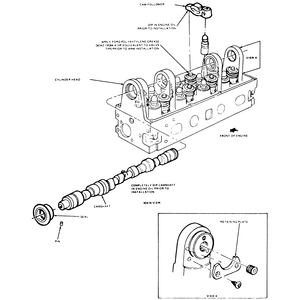
|
- Camshaft installation is in the reverse order of service removal procedure.
Coat the camshaft with a heavy SF (or better) grade oil before sliding it
into the cylinder head. Install a new front seal. Apply a coat of sealer or
teflon tape to the cam drive gear bolt before installation. After any procedure
requiring removal of the rocker arms, each lash adjuster must be fully collapsed
after assembly, then released. This must be done before the camshaft is turned.
- Refill cooling system. Start engine and check for leaks. Roadtest the vehicle
for proper operation.
- Disconnect the negative battery cable.
- Remove the air cleaner hoses.
- Remove the fan and spacer, and shroud.
- Drain the cooling system. Remove the radiator.
CAUTION
When draining the coolant, keep in mind that cats and dogs are attracted
by ethylene glycol antifreeze, and are quite likely to drink any that is
left in an uncovered container or in puddles on the ground. This will prove
fatal in sufficient quantity. Always drain the coolant into a sealable container.
Coolant should be reused unless it is contaminated or several years old.
- Remove the condenser.
- Relieve the fuel system pressure.
- Remove the fuel lines at the fuel supply manifold.
- Tag and disconnect all vacuum hoses in the way.
- Tag and disconnect all wires in the way.
- Remove the engine front cover and water pump.
- Remove the alternator.
- Remove the power steering pump and secure it out of the way. DO NOT disconnect
the hoses!
- Remove the air conditioning compressor and secure it out of the way. DO
NOT disconnect the hoses!
- Remove the throttle body.
- Remove the fuel injection harness.
- Drain the engine oil into a suitable container and dispose of it properly.
CAUTION
The EPA warns that prolonged contact with used engine oil may cause a number
of skin disorders, including cancer! You should make every effort to minimize
your exposure to used engine oil. Protective gloves should be worn when
changing the oil. Wash your hands and any other exposed skin areas as soon
as possible after exposure to used engine oil. Soap and water, or waterless
hand cleaner should be used.
- Turn the engine by hand to 0 BTDC of the power stroke on No. 1 cylinder.
- Disconnect the spark plug wires from the plugs.
- If equipped, remove the distributor cap with the spark plug wires as an
assembly.
- If equipped, matchmark the rotor, distributor body and engine. Disconnect
the distributor wiring harness and remove the distributor.
- Remove the valve covers.
- Remove the intake manifold.
- Loosen the rocker arm bolts enough to pivot the rocker arms out of the way
and remove the pushrods. Identify them for installation. They must be installed
in their original positions!
- Remove the valve lifters. Identify them for installation.
- Remove the crankshaft pulley/damper.
- Remove the starter.
- Remove the oil pan.
- Turn the engine by hand until the timing marks align at TDC of the power
stroke on No.1 piston.
- Check the camshaft end-play. If excessive, you'll have to replace the thrust
plate.
- Remove the camshaft gear attaching bolt and washer, then slide the gear
off the camshaft.
- Remove the camshaft thrust plate.
- Carefully slide the camshaft out of the engine block, using caution to avoid
any damage to the camshaft bearings.
To install:
- Oil the camshaft journals and cam lobes with heavy SG engine oil (50W).
Install the spacer ring with the chamfered side toward the camshaft, then
insert the camshaft key.
- Install the camshaft in the block, using caution to avoid any damage to
the camshaft bearings.
- Install the thrust plate. Tighten the attaching screws to 84 inch lbs.
- Rotate the camshaft and crankshaft as necessary to align the timing marks.
Install the camshaft gear and chain. Tighten the attaching bolt to 46 ft.
lbs. (62 Nm).
| Fig. 2: Camshaft installation — 3.0L
engines
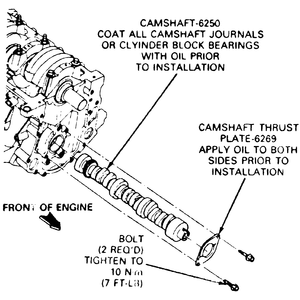
|
| Fig. 3: Rocker arm positioning — 3.0L
engines
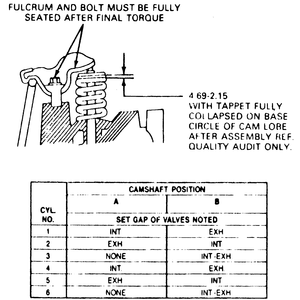
|
- Coat the tappets with 50W engine oil and place them in their original locations.
- Apply 50W engine oil to both ends of the pushrods. Install the pushrods
in their original locations.
- Pivot the rocker arms into position. Tighten the fulcrum bolts to 8 ft.
lbs. (11 Nm).
- Rotate the engine until both timing marks are at the tops of their sprockets
and aligned. Tighten the following fulcrum bolts to 18 ft. lbs. (24 Nm):
- No.1 intake
- No.2 exhaust
- No.4 intake
- No.5 exhaust
- Rotate the engine until the camshaft timing mark is at the bottom of the
sprocket and the crankshaft timing mark is at the top of the sprocket, and
both are aligned. Tighten the following fulcrum bolts to 18 ft. lbs. (24 Nm):
- No.1 exhaust
- No.2 intake
- No.3 intake and exhaust
- No.4 exhaust
- No.5 intake
- No.6 intake and exhaust
- Now, tighten all the bolts to 24 ft. lbs. (33 Nm).
- Turn the engine by hand to 0 BTDC of the power stroke on No. 1 cylinder.
- Install the engine front cover and water pump assembly.
- Install the oil pan.
- Install the crankshaft damper/pulley.
- Install the intake manifold and tighten the mounting bolts to the specifications
and in the sequence described under Intake Manifold removal and installation.
- Install the valve covers.
- Install the injector harness.
- If equipped, install the distributor.
- Install the cap and wires.
- Install the throttle body.
- Install the alternator.
- Install the power steering pump.
- Install the compressor.
- Connect all wires.
- Connect all vacuum lines.
- Install the radiator and condenser.
- Install the fan and clutch.
- Install the fuel lines.
- Install the starter.
- Refill the cooling system.
- Replace the oil filter and refill the crankcase with the specified amount
of engine oil.
- Reconnect the battery ground cable.
- Start the engine and check the ignition timing and idle speed. Adjust if
necessary. Run the engine at fast idle and check for coolant, fuel, vacuum
or oil leaks.
- Disconnect the negative battery cable.
- Drain the engine oil into a suitable container and dispose of it properly.
CAUTION
The EPA warns that prolonged contact with used engine oil may cause a number
of skin disorders, including cancer! You should make every effort to minimize
your exposure to used engine oil. Protective gloves should be worn when
changing the oil. Wash your hands and any other exposed skin areas as soon
as possible after exposure to used engine oil. Soap and water, or waterless
hand cleaner should be used.
- Drain the cooling system.
CAUTION
When draining the coolant, keep in mind that cats and dogs are attracted
by ethylene glycol antifreeze, and are quite likely to drink any that is
left in an uncovered container or in puddles on the ground. This will prove
fatal in sufficient quantity. Always drain the coolant into a sealable container.
Coolant should be reused unless it is contaminated or several years old.
- Remove the radiator.
- Remove the condenser.
- Remove the fan and spacer, and shroud.
- Remove the air cleaner hoses.
- Tag and remove the spark plug wires.
- Remove the EDIS ignition coil and bracket.
- Remove the crankshaft pulley/damper.
- Remove the clamp. bolt and oil pump drive from the rear of the block.
- Remove the alternator.
- Relieve the fuel system pressure.
- Remove the fuel lines at the fuel supply manifold.
- Remove the upper and lower intake manifolds as previously described.
- Remove the rocker arm covers.
- Remove the rocker shaft assemblies.
- Remove the pushrods. Identify them for installation. They must be installed
in their original positions!
- Remove the tappets. Identify them for installation.
- Remove the oil pan as previously described.
- Remove the engine front cover and water pump.
- Place the timing chain tensioner in the retracted position and install the
retaining clip.
- Turn the engine by hand until the timing marks align at TDC of the power
stroke on No.1 piston.
- Check the camshaft end-play. If excessive, you'll have to replace the thrust
plate.
- Remove the camshaft gear attaching bolt and washer, then slide the gear
off the camshaft.
- Remove the camshaft thrust plate.
- Carefully slide the camshaft out of the engine block, using caution to avoid
any damage to the camshaft bearings.
To install:
- Oil the camshaft journals and cam lobes with a heavy (50W) SG grade (or
better) engine oil.
- Install the camshaft in the block, using caution to avoid any damage to
the camshaft bearings.
- Install the thrust plate. Make sure that it covers the main oil gallery.
Tighten the attaching screws to 96 inch lbs. (11 Nm).
| Fig. 4: Camshaft installation — 4.0L
engines
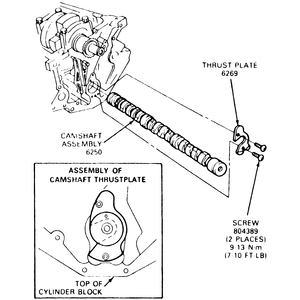
|
| Fig. 5: Timing mark alignment — 4.0L
engines
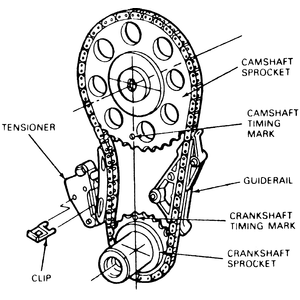
|
- Rotate the camshaft and crankshaft as necessary to align the timing marks.
Install the camshaft gear and chain. Tighten the attaching bolt to 50 ft.
lbs. (68 Nm).
- Remove the clip from the chain tensioner.
- Install the engine front cover and water pump assembly. Refer to the necessary
service procedures in this Section.
- Install the crankshaft damper/pulley.
- Install the oil pan.
- Coat the tappets with 50W engine oil and place them in their original locations.
- Apply 50W engine oil to both ends of the pushrods. Install the pushrods
in their original locations.
- Install the upper and lower intake manifolds.
- Install the rocker shaft assemblies.
- Install the valve covers.
- Install the fan and clutch.
- Install the fuel lines.
- Install the oil pump drive.
- Install the alternator.
- Install the EDIS coil and plug wires. Coat the inside of each wire boot
with silicone lubricant.
- Install the radiator and condenser.
- Refill the cooling system.
- Replace the oil filter and refill the crankcase with the specified amount
of engine oil.
- Reconnect the battery ground cable.
- Start the engine and check the ignition timing and idle speed. Adjust if
necessary. Run the engine at fast idle and check for coolant, fuel, vacuum
or oil leaks.
| Fig. 6: Camshaft and cylinder head components — 2.6L
engine
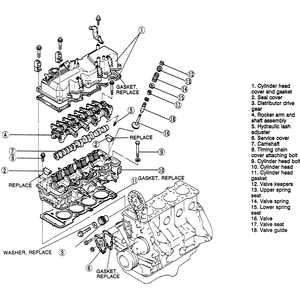
|
- Disconnect the negative battery cable, and drain the cooling system.
- Remove the rocker cover. Check to ensure the engine is set on TDC. The timing
mark on the camshaft sprocket should be 90 degrees to the right, parallel
to the top of the cylinder head. Make sure the yellow crankshaft pulley timing
mark is aligned with the indicator pin.
- Remove the seal cover.
- Mark the position of the distributor rotor in relation to the distributor
housing, and the distributor housing in relation to the cylinder head. Remove
the distributor. Do not rotate the engine after distributor removal.
- Hold the crankshaft pulley with a suitable tool and remove the distributor
drive gear/camshaft pulley retaining bolt and the drive gear. Remove the upper
timing cover assembly.
- Push the timing chain adjuster sleeve in towards the left, and insert a
2mm diameter x 45mm long pin into the lever hole to hold it in place.
- Wire the chain to the pulley and remove the pulley from the camshaft. Do
not allow the sprocket and chain to fall down into the engine and cause the
chain to become disengaged from the crankshaft sprocket.
- Remove the rocker arm/shaft assembly.
- Remove the camshaft.
- Inspect the camshaft for wear and/or damage and replace if necessary.
To install:
- Apply clean engine oil to the camshaft journals, lobes and bearings. Install
the camshaft with the dowel pin facing upwards.
- Install the rocker arm/shaft assembly and tighten the bolts, in sequence,
in 2–3 steps to 14–19 ft. lbs. (19–25 Nm). Make sure the
rocker arm shaft spring does not get caught between the shaft and mounting
boss during installation.
- Install the camshaft sprocket and tighten the bolt to 37–44 ft. lbs.
(50–60 Nm).
NOTE: Remove all old sealer from the distributor drive
gear and apply sealer to the gear face, then seat the gear fully on the
camshaft.
- Install the distributor drive gear and distributor.
- Install the seal cover.
- Coat a new gasket with silicone sealant and install on the rocker arm cover.
Install the cover and tighten the bolts to 53–78 inch lbs. (6–9
Nm).
- Remove the timing chain adjuster sleeve pin. Install the upper timing chain
cover.
- Connect the negative battery cable. Fill and bleed the cooling system.
- Run the engine and check for leaks and proper operation. Check the idle
speed and ignition timing.
| Fig. 7: Camshaft and cylinder head components — 3.0L
engine
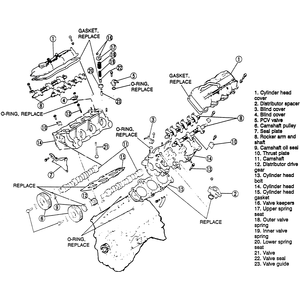
|
CAUTION
Fuel injection systems remain under pressure after the engine has been turned
OFF. Properly relieve fuel pressure before disconnecting any fuel lines. Failure
to do so may result in fire or personal injury. Do not allow fuel spray or fuel
vapors to come in contact with a spark or open flame. Keep a dry chemical fire
extinguisher nearby. Never store fuel in an open container due to risk of fire
or explosion.
- Disconnect the negative battery cable.
- Drain the cooling system.
- Relieve the fuel system pressure.
- Remove the PCV valve and blind cover.
- Remove the cylinder head.
- If removing the driver's side camshaft, remove the distributor and the distributor
spacer.
- Remove the camshaft sprocket bolt and sprocket.
- Remove the seal plate. Pry out the camshaft seal, being careful not to damage
the seal housing.
- Remove the rocker arm/shaft assembly.
- Remove the thrust plate bolts and remove the thrust plate. Slide the camshaft
out of the cylinder head. If removing the driver's side camshaft, remove the
distributor drive gear.
- Inspect the camshaft for wear and/or damage and replace if necessary.
To install:
NOTE: If installing the driver's side camshaft, remove
all old sealer from the distributor drive gear and apply sealer to the gear
face, then seat the gear fully on the camshaft.
- Apply clean engine oil to the camshaft journals, lobes and bearings. Install
the camshaft and the thrust plate. Tighten the thrust plate to 69–95
inch lbs. (7.8–11.0 Nm).
- Apply clean engine oil to a new camshaft seal lip and press the seal into
the cylinder head, using a seal installer.
- Install the rocker arm/shaft assembly and tighten the bolts, in sequence,
in 2–3 steps to 14–19 ft. lbs. (19–25 Nm). Make sure the
rocker arm shaft spring does not get caught between the shaft and mounting
boss during installation.
- Install the seal plates and tighten the bolts to 69–95 inch lbs. (7.8–11.0
Nm).
- Align and install the camshaft sprocket. Tighten the bolt to 52–59
ft. lbs. (71–80 Nm).
- If installing the driver's side camshaft, apply clean engine oil to a new
O-ring and install on the distributor spacer. Install the spacer and tighten
the nuts to 69–95 inch lbs. (7.8–11.0 Nm). Install the distributor.
- Install the cylinder head.
- Install the blind cover and PCV valve.
- Connect the negative battery cable.
- Fill and bleed the cooling system.
- Run the engine and check for leaks and proper operation. Check the idle
speed and ignition timing.



